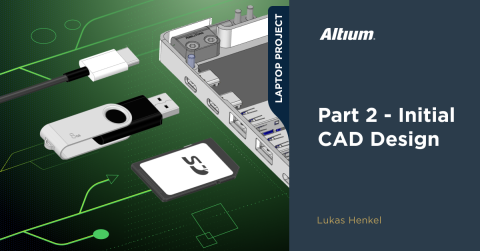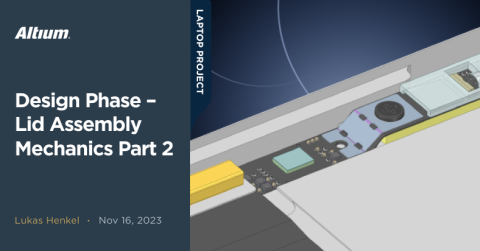Concept Phase – Cooling and Airflow Part 1

Milestone
Concept Phase – Cooling and Airflow Part 1
| Created: July 26, 2023More Milestones
| Coming soonIn this installment of the open-source laptop project, we will take a closer look at the cooling system. First, we will focus on the airflow inside the device and find out what we need to consider to meet the requirements defined in the previous article.
During the concept phase we looked at key technical requirements that should be implemented in the final unit. One of those requirements was that no air can be pulled in on the underside of the device. Many, if not most, laptops on the market do just that—and with good reason. Before we dive into the CAD model and start working on our own design, let's take a look at the status quo and see what we can learn from the proven approach.
Taking a look at the Dell XPS 9500
To show how a cooling solution is implemented in a modern laptop, we will look at the Dell XPS 9500. This is a 15-inch device with an i7-10750 processor and an NVIDIA GTX 1650 Ti GPU, which can draw in excess of 100 watts under full load. The cooling solution will therefore be much larger than that of a 13-inch device, but the operating principle remains the same.
On the bottom of the device we see a large number of air intake slots. The array of ventilation slots extends across almost the entire length of the device's bottom cover.

Bottom view of the DELL XSP 9500
Removing the bottom cover reveals that only a small part of the ventilation slots are actually used by the internal fans. Approximately 50% of the air vents are closed with an insulating foil. In the areas where air can be actively pulled in, there is no air filter present in front of the fans. Fine mesh air filters can have a particularly high flow resistance. This is why it’s interesting that a system without an additional filter on the lower pressure side can manage over a usage period of three years without any loss of performance due to blocked cooling fins. Of course, this example is not entirely representative as the number of particles and the particle size varies from place to place.

Bottom cover of the device
The machine uses two radial fans, each with a zipper fin heat sink package located directly in front of the fan outlet. The two heat sink packets are connected to the main CPU and GPU using two 8mm flat heat pipes.
Overlaying the two images of the bottom cover and the component arrangement shows how the airflow within the system develops.

Airflow within the XPS 9500
The benefits of this arrangement are:
- The flow path is as short as possible, which minimizes the pressure drop and enables a higher air velocity through the heat sink;
- No air is forced over the mainboard or any other internal component making dust accumulation on the electronics unlikely;
- The cool air intake and hot air outlet are spaced wide apart.
The drawbacks of this arrangement are:
- The ventilation slots on the bottom are easily blocked when using the laptop on a soft surface;
- Having no airflow across the mainboard means all heat generating components need a large heat spreader, or need to be thermally coupled to the CPU or GPU heat spreader.
Airflow concept of the open-source laptop
The benefits of the previous approach are very good arguments for placing the air intake on the bottom of the device. However, there should be ways to move the air intake either to the back of the device or to the sides without creating unnecessary bottlenecks.
So, we considered two approaches for the cooling concept design:
For the first approach, the air is pulled in on the right side of the device, passed over the mainboard, and vented on the left side of the laptop. The heat sink packet sits directly between the ventilation slots on the left side of the laptop and the radial fan.
The major drawback of this approach is the mainboard needs to be located in the front of the laptop, underneath the trackpad. The battery pack would have to be located underneath the keyboard. This shifts the laptop's center of mass to the back, which makes it unstable when opening and using it with the screen bent all the way back. We discarded this approach later on as a result.
The following illustration shows how the airflow would have developed in the first concept. (We will look at how to set up a simulation like this using free and open-source tools later.)

Flow path of the discarded cooling concept
Since relocating the battery to the rear is out of the question, a new arrangement of the internal components had to be designed. And because the mainboard is now located underneath the keyboard, pulling air in from the sides is no longer an option as the space needed for the air vents is already taken up by the IO interfaces.
As an alternative approach, we placed both the air inlet and outlet on the back of the laptop. This way, almost the entire length of the laptop can be utilized as air vents minimizing the flow resistance. If the inlet is placed near the outlet, you must be careful not to draw hot air back into the machine.
The updated airflow path looks like this:

Updated airflow path
With this approach, a large section on the back of the device is dedicated to the cooling air inlet. Since the cross-sectional area of this air inlet is relatively large, we can fit a fine mesh air filter in front of the inlet without causing too much pressure drop. The filtered cooling air passes across the mainboard and allows us to cool components like the SSDs, memory, VRMs, and supporting circuitry. And because the cooling air is filtered, we also reduce the risk of dust accumulating on the mainboard. An added benefit of pulling the cooling air across the mainboard is we can make sure pockets of hot air do not form between the keyboard and the mainboard. This should effectively reduce the keyboard temperature under heavy use.
The following rendering illustrates the new positioning of the mainboard underneath the keyboard module:

Positioning of the mainboard underneath the keyboard module
Cooling fan intake clearance
With the airflow set up as illustrated above, we have a valid approach to cooling the system. Now, we have to integrate this concept into CAD and verify the approach using simulations in the initial iteration.
Before refining the CAD model, we need to understand constraints around the placement of the fan in the system. Special attention must be paid to the clearance around the cooling fan inlet. The fan air intake is positioned directly underneath the keyboard module providing only a small gap to draw in air. We could verify the pressure drop of that section using simulations. However, additional aerodynamic effects come into play when placing obstacles very close to the intake of a fan. Axial fans are especially susceptible to blockages in the inlet path. While centrifugal fans are generally more suited for high flow resistance environments, a sub optimal air flow close to the inlet can have a large impact on performance.
We will want to make sure that no swirl or rotating flows occur at the inlet of the fan. This can degrade the fan performance and create additional noise. We also need to ensure that an evenly distributed mass flow enters the fan so that each part of the fan rotor experiences an even pressure differential.
Rotating flows at the fan inlet can be created by the influence of the fan rotor itself if a planar obstruction is placed close to the intake. Unfortunately, this is exactly the mounting position of the fan used in the outlined cooling concept. Modeling these rotating flows using simulations is very difficult and requires exact knowledge of the fan blade geometry. Since simulation is not a feasible option, we will have to take measurements of the fan.
Simplified fan measurement
The objective is to determine the minimum distance that a planar obstacle must be kept from the fan inlet.
In the experimental setup, the air velocity of a cooling fan is measured without any obstruction on the inlet of the fan. A blocking board is used, which is brought closer and closer to the fan air inlet while the air velocity at the outlet of the fan is monitored. This way, a function of the output air velocity versus the distance of the blockage to the fan inlet can be fixed. This function should tell us what the minimum distance of the obstacle to the inlet should be without decreasing the performance of the fan by more than 10%.
To achieve the desired result, a repeatable method of measuring the air velocity at the fan outlet is required. Since I don't have access to an anemometer that can measure the air velocity of such a small fan outlet, we will have to improvise.
For this, we will use two cooling fans coupled together with only one fan that is actively driven. The second fan is driven by the air flow generated by the first fan, so we can make use of the tacho signal of the second fan to measure the rotor speed with a frequency counter.
When trying to drive a fan only with the airflow provided by an external source, we can quickly run into a problem—especially at low flow rates. The magnetic cogging torque of the fan motor causes the fan to rotate only at high flow velocities.
To avoid this, the second fan must be modified by removing the stator while leaving the circuit board with the Hall sensor for the tachometer signal intact. Here’s how we did it:

-
Then, using an arrangement of magnets, we can push the rotor out of its MagFix bearing:

-
Finally, we are able to remove the fan motor without damaging the controller PCB:

After putting the fan back together with these modifications, it can now be used to indicate airflows of a very low velocity. Using the tacho output, the rotation rate can be accurately quantified. The fan outputs two pulses per revolution.
In order to perform repeatable and reliable measurements, a sound mechanical design is necessary. A simple 3D printed holder is used to secure the two fans in place while providing an air guide from the testing device to the measurement fan.

3D printed test fixture

3D printed test fixture after installing the test and measurement fan
Results of the simplified fan measurements
Using the test measurement setup outlined above, a blocking board was placed in front of the DUT inlet. The distance between the blocking board and the fan air intake varied between 0mm and 2mm in 0.1mm steps. A test run without the blocking board in place was used as a reference for the maximum achievable air velocity, while at the same time, the sound level was recorded.

Measurement result air velocity vs. distance to inlet obstruction

Noise level spectral distribution
The measurement result shows that we need an intake gap of at least 1.1mm to ensure the performance of the fan does not drop by more than 10%. The spectral distribution of the fan noise looks surprisingly similar for all measurement runs. There is some variance in the higher frequency ranges, especially for the low distance measurements—which is to be expected. The measurement runs with a distance of more than 1mm show only very small deviations in the noise spectrum from each other.
Airflow simulation
The previous measurements provided us with important insights that can now be transferred over to the CAD model. The fan should be integrated with a distance of at least 1.1mm between the fan inlet and the keyboard module mounted above the fan.
With the correct mounting spacer for the radial fan, the clearance between the keyboard module and the top side of the fan is roughly 1.92mm. From that value, 0.5mm needs to be subtracted for a stiffener and insulating foil underneath the keyboard. Fortunately, the distance is still larger than 1.1mm. With the preliminary placement of the fan in the system done, a simulation model can be created from the existing geometry.

Distance between the fan inlet and the underside of the keyboard module
The goal of the simulation model is to provide a pressure drop between the air intake of the laptop and the air exhaust. The heat sink packet and the air filter will create the largest pressure drop in the flow path. These two aspects are yet to be defined and will be taken into account in a future simulation. For now, our focus is only on the flow profile within the laptop and the associated pressure drop.
The pressure drop of the internal air path will be calculated for several volumetric flow rates. Sweeping across several flow rates allows us to create a function of the pressure drop versus the volumetric flow rate. The intersection between this function and the fan curve given by the fan datasheet tells us the final volumetric air flow and therefore air velocity generated by the fan in the system. The function of the flow profile pressure drop needs to be offset by the function of the pressure drop for the heat sink packed and air filter once these have been calculated.
To prepare the simulation, the CAD model needs to be simplified and the volume for the fluid simulation domain needs to be extracted. In the first step, the components located on the mainboard will be substituted with bounding box models. This greatly reduces the geometry complexity as well as the complexity of the simulation mesh that will be created later on.

Components on the mainboard with original geometry
The bounding box is set up in such a way that it follows large features of the geometry, but encloses features with a high vertex count. Small but high detail features won't have a meaningful impact on the flow profile and can therefore be left out.

Bounding boxes wrapped around critical geometry features within the simulation domain
With the simplified representation of the components in place, the air volume on the inside of the laptop can be extracted with a simple boolean difference operation between the laptop case, the mainboard with all its components, and the simplified air volume.

Air volume that will be used for the simulation
Running the first simulation at a volumetric flow rate of 1m³/h provides the following velocity and pressure distribution:

First simulation results
This simulation provides us with two very important insights. The first result is the average pressure drop between inlet and outlet of 15 pascal. The second result refers to the dark blue dot visible in the heat map of the pressure field. This localized area of very low pressure is the center of a rotating air current—a small vortex directly above the fan inlet. This rotation develops because the air current coming into the domain has an impulse perpendicular to the fan axis. As the air gets drawn closer to the fan, it speeds up and forms a fast rotating vortex due to the conservation of momentum.
As described in the previous section, a swirling air flow at the inlet of a fan causes additional noise and reduces efficiency. Therefore, we have to find a way to prevent a vortex from forming. That will be a challenge for a future update.
Performing a sweep across the volumetric flow rate, the simulation reveals the following pressure drop versus flow rate curve:

Pressure drop versus volumetric flow rate of the internal air path of the laptop
The data sheet of the fan currently under consideration provides the following pressure vs. volumetric flow rate graph:

Datasheet of the fan
Extracting the X and Y values of the fan curve and placing them in the same diagram as the simulated pressure drop shows us two intersecting functions. The intersection between the fan curve and the simulated pressure drop curve indicates which volumetric flow rate and which pressure will be established in the unit. However, we are still missing two critical parameters of the fin; the heat sink pressure drop and the air filter pressure drop. With the above established workflow, adding these values later on will not be an issue.
The resulting airflow for the system without heat sink and air filter should be approximately 1.5m³/h at a pressure drop of 28 pascal.

Fan curve vs. pressure drop curve
In the upcoming project updates, we will further refine the airflow concept and dig deeper into using open-source tools for flow and heat transfer simulation. We are also going to design, assemble, and test the first components of the laptop.
There is still a lot to explore, so stay tuned!











